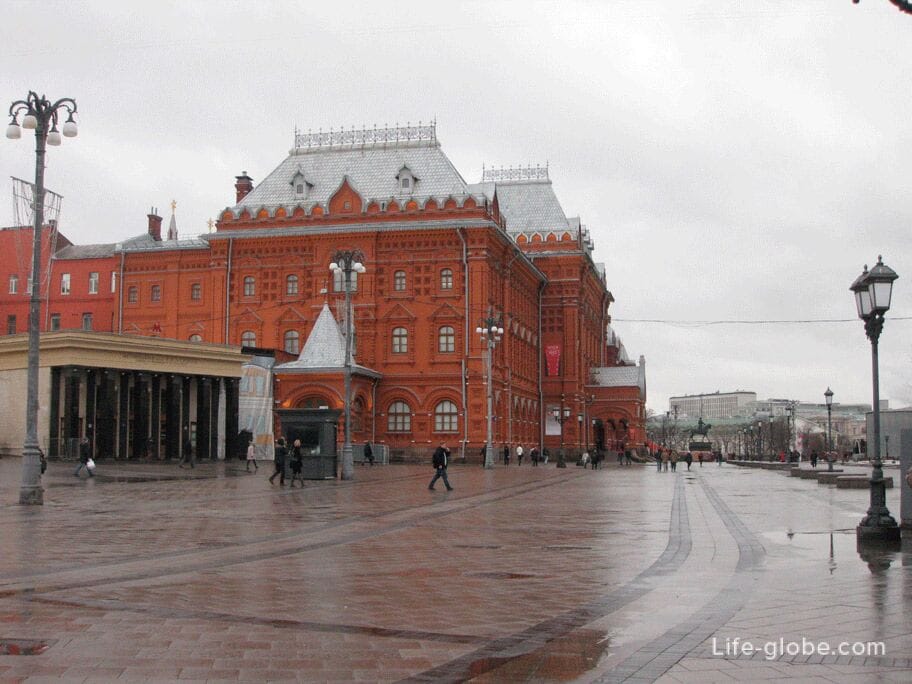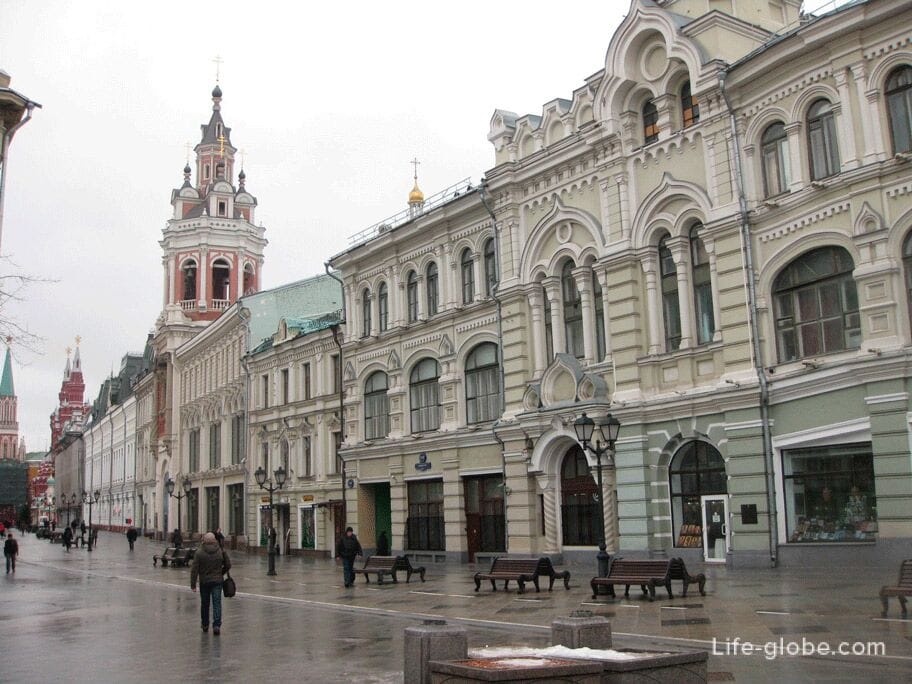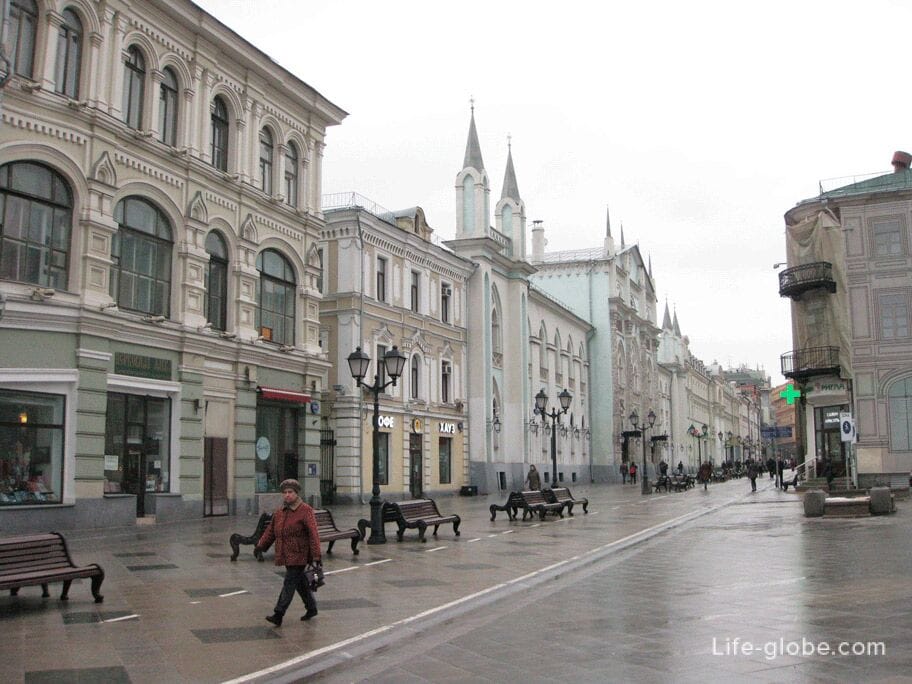
Revolution Square is one of the central squares of Moscow. Until 1918, the square was called Voskresenskaya Square, it was named after the Resurrection Gate of the same name.
Revolution Square does not represent anything special, such a simple small square in the center of a gray gas-polluted city, but ... whatever one may say, this gray and nondescript city is the capital of the Russian Federation, and Revolution Square is one of the central squares of this capital, with annual visits by thousands of tourists and good statistics according to the results of the wordstat. Actually, for this reason, we talk about the area on the pages of this blog.

In the photo above, on the right, you can see the corner of the red brick building, this is the Museum of the Patriotic War of 1812. The yellow building is the entrance to the metro to the museum, just at the Revolution Square and Teatralnaya metro stations. Then you can see the former red brick defensive tower and part of the Kitay-Gorod wall.
Once the Neglinnaya River flowed through the territory of the square, now it is enclosed in a collector.
The Parade ground of the Revolution is located on the territory of the Tverskoy district of Moscow directly between Manezhnaya Square and Theater Square. Yes, what is there between two squares, it is within walking distance of Red Square, the Kremlin, the Mausoleum, the Eternal Flame and the Alexander Garden.
The easiest and fastest way to get to the square is by metro. You can get out at the stations Teatralnaya, Okhotny Ryad or Revolution Square. If you want to get directly to the square itself, then it is best to choose the Teatralnaya metro station, well, or the Revolution Square of the same name. From the Okhotny Ryad station you will have to walk 30 meters.
Speaking of Okhotny Ryad, this station is located on the Manezhnaya Square adjacent to Revolution Square. We talked about Manezhnaya Square in a previous article, you can see it here.
The photo shows the Museum of the Patriotic War of 1812 and the exit to Manezhnaya Square

If you turn your back to Revolution Square, then you will see Theater Square. Also, nothing special and beautiful is not representing itself. At the end of the Theater Square is the famous The Bolshoi Theater.
A large number of cafes and restaurants in the center of Moscow are concentrated on Revolution Square, with inadequately inflated prices corresponding to the capital. There are restaurants such as the Old Tower, Godunov, the beer restaurant Burgomaster, the Italian restaurant cafe La Cipolla, Cafe Marinade and many others.
From the square there is a view of the Zaikonospassky Monastery and Church of the Epiphany of the Lord

Zaikonospassky Monastery Moscow is an active Orthodox Stavropol monastery on Nikolskaya Street, in Kitay-Gorod. Before the October Revolution, it was a second-class Stavropol unsociable men's monastery and was called Spassky. It was also known as the "teacher's" due to the creation of an educational school within its walls, which was then reorganized into the Slavic-Greek-Latin Academy, which became the basis of the Moscow Theological Academy.
The official website of the Zaikonospassky Monastery: zaikonospasskiy.ru .
Address of the Zaikonospassky Monastery: Russia, 103012, Moscow, Nikolskaya str., 7-9 (m. Theatrical).
The Church of the Epiphany of the Lord orThe Epiphany Monastery in Moscow is a former monastery in Kitay-Gorod on Bogoyavlensky Lane.
If you go from Revolution Square to the alley behind the walls of the former Kitaygorodsky fortress wall, then you can go to Nikolskaya Street toNikolsky (Iversky) shopping malls, and from there, turning right to Red Square, the Kremlin and GUM.
Nikolskaya Street is a small pedestrian street, on both sides of which there are Art Nouveau buildings, with shops and restaurants on the first and ground floors, and benches and lanterns of beautiful shapes are installed in the center.
Nikolsky shopping malls have been restored, quite clean and well-groomed, there is something to see. This is probably one of the places in Moscow where we can recommend a walk.


Initially, the Neglinnaya River flowed through the territory of the future Revolution Square. In 1516, the river was dammed. And on this place there was a watermill and flour shops. There was a lively trade in flour shops with nothing but flour.
In the XVI century, the first fortifications of the Chinese Wall were built around the future square. In 1534-1538, when the wall was completely erected, Kitay-gorod appeared. A gate called the Resurrection Gate opened onto the square itself.
In 1595, at the turn of the XVI-XVII centuries, a stone bridge of the same name was thrown across the Neglinka River at the Resurrection Gate. Over time, commercial buildings appeared nearby. Since then, market trade has been conducted on and near the bridge itself.
In the early 1700s, earthen bastions were erected in front of the wall of Kitay-Gorod by order of Peter I, which served at that time as a fortification and protection in case of a possible invasion of the Swedes.
In 1741, the Resurrection Bridge was rebuilt. And at the end of the XVII century, the Resurrection Gate was built with two tent towers. At the same time, the Iver Chapel appeared in front of the gate.
The currently famous Revolution Square was formed only at the beginning of the XIX century, when the Neglinnaya River was removed into the pipe, and the bastions were demolished. The square was named Voskresenskaya in honor of the Resurrection Gate of Kitay-Gorod facing it.
Later, the Resurrection Bridge was covered with earth, and to the west of the square on the site of the riverbed was placed Alexander Garden, which exists to this day.
In 1879, the merchant Karzinkin's house was erected on the north side of the square, which soon housed a hotel. Later, Karzinkin's house was demolished.
In 1890-1892, a new building of the Moscow City Duma was erected on the site of the demolished building. From 1936 to 1993, the building housed the V.I. Lenin Museum. And in 1993, the building was transferred to the State Historical Museum.
In 1917, during the October armed uprising, fierce fighting took place on the square. It was in memory of these events that the square was renamed from Voskresenskaya to Revolution Square.
In 1918, a monument to K. Marx and F. was unveiled on Revolution Square . Engels, which lasted only a few years, as it was made of short-lived materials.
In 1935, the building of the hotel "Moscow" was built, now the building houses a luxury hotel - Four Seasons Hotel Moscow. In the 1970s, an extension was made to it.
In 1938, the metro stations "Sverdlov Square" (renamed Theater in 1990) and "Revolution Square" were opened, for which a common entrance pavilion was built. The general entrance pavilion of the Moscow metro works to this day.
In 1997, the Museum of Archeology of Moscow, located underground, was opened between Revolution and Manezhnaya Squares. One of the main exhibits of the museum is the foundation of the Resurrection Bridge found during excavations.